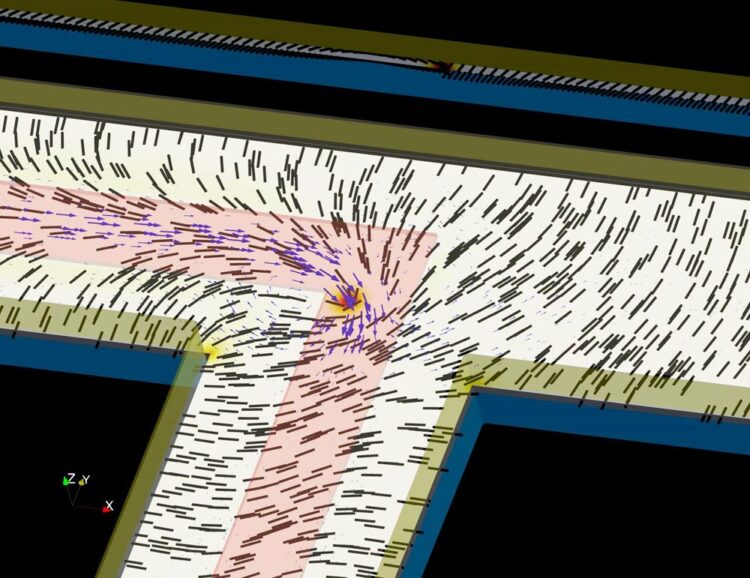Active liquid crystal systems examined in search of autonomous materials systems

Simulation snapshot of a self-propelling topological defect in an active liquid crystal guided by a light pattern (shone in pink region).
Credit: Prof. Zhang Rui, HKUST
Liquid Crystals (LC) are widely deployed in display technology and optical fibres. From smartphones in your pockets to large screen TVs, LCs are everywhere, as this special state of matter has been found in colorful soap bubbles as well as certain living tissues.
But LCs are by no means limited to use in gadgets or electronic devices. For quite some time, scientists have been studying the possibility of creating “active nematics”, a particular class of active LCs, which consist of self-driven units capable of converting chemical or other forms of energy into motion. When administered the proper stimuli, scientists have found that they can generate a predictable response from different LCs, which allows for design of smart, multifunctional materials systems, such as a bacteria-killing multiphase systems capable of self-regulating and reporting the presence and elimination of pathogens. Previous studies have demonstrated that light patterns can be harnessed to direct the creation and motion of topological defects in LCs, which could serve as cargo carriers or signal transmitters that further enhance the response of the material.
Their findings were published in the journal Nature Materials on February 18,2021. The work was a successful collaboration between several research groups, including Professors Juan de Pablo, Margaret Gardel, Vincenzo Vitelli and Aaron Dinner from the University of Chicago and Professor Zev Bryant from Stanford University.
Sculpting well-defined structures in liquids could in principle enable the engineering of functionalities that are otherwise only possible in solid materials. Existing efforts towards this goal often-times rely on multiple components or phases that are far from equilibrium and difficult to control, thereby limiting their application.
Introducing local activity into such liquid structures could therefore open opportunities for a wide range of applications, for example, mimicking the behavior of cells. However, manipulating these embedded or sculpted structures remains difficult. Thanks to the underlying local molecular orientational field, topological defects in LCs represent stable inhomogeneous structures, which may allow the embedding of flexible structures into a liquid medium.
“Active LCs are a nascent field, and many phenomena remain to be elucidated and applied,” said Prof. ZHANG Rui, Assistant Professor in the Department of Physics, HKUST, who is one of the co-authors of the research. “Our study investigated different active LC systems, including natural systems, such as cell colonies, biopolymers and bacteria, as well as synthetic systems, which mimic the adaptive and autonomous behaviors found in living matter.”
The study, which was recently published in Nature Reviews Materials, reveals that distinct types of active LC systems all exhibit striking similarities with one another but, more importantly, these systems exhibit a high sensitivity to the environment, such as interfacial events, which makes them potentially programmable and autonomous for a wide range of applications.
“The sensitivity to interfacial events, such as temperature gradients and hydrodynamic flows, can be exploited for the detection of ionic species, gases, toxins, and bacteria,” noted Zhang. “By engineering the corresponding interfaces, we can impart a transient activity to these LC systems, which would make these self-propelling LCs a potential candidate for applications such as microreactor design and targeted drug delivery”.
“We knew these active materials were beautiful and interesting, but now we know how to manipulate them and use them for interesting applications,” says Professor Juan de Pablo, the vice President and Professor of Molecular Engineering of the University of Chicago, a corresponding author of the study said. “That’s very promising.”
“Active materials are promising in the sense that they don’t need real-time communications, human intervention, and external power supply”, says Zhang. In the future, Zhang group will continue to collaborate with the Chicago group to explore the possibility of logic operations through these active liquid crystals, which could lead to an applicable autonomous material that can compute and take necessary actions based on their calculations. “With the realization of such intelligent materials, we don’t have to read the manual of a medicine, and the capsule would decide how much dose to be released while inside your body; or your window can decide its color and whether to open even in a catastrophic event including an electricity blackout”, says Zhang.
All latest news from the category: Materials Sciences
Materials management deals with the research, development, manufacturing and processing of raw and industrial materials. Key aspects here are biological and medical issues, which play an increasingly important role in this field.
innovations-report offers in-depth articles related to the development and application of materials and the structure and properties of new materials.
Newest articles

Parallel Paths: Understanding Malaria Resistance in Chimpanzees and Humans
The closest relatives of humans adapt genetically to habitats and infections Survival of the Fittest: Genetic Adaptations Uncovered in Chimpanzees Görlitz, 10.01.2025. Chimpanzees have genetic adaptations that help them survive…

You are What You Eat—Stanford Study Links Fiber to Anti-Cancer Gene Modulation
The Fiber Gap: A Growing Concern in American Diets Fiber is well known to be an important part of a healthy diet, yet less than 10% of Americans eat the minimum recommended…

Trust Your Gut—RNA-Protein Discovery for Better Immunity
HIRI researchers uncover control mechanisms of polysaccharide utilization in Bacteroides thetaiotaomicron. Researchers at the Helmholtz Institute for RNA-based Infection Research (HIRI) and the Julius-Maximilians-Universität (JMU) in Würzburg have identified a…



